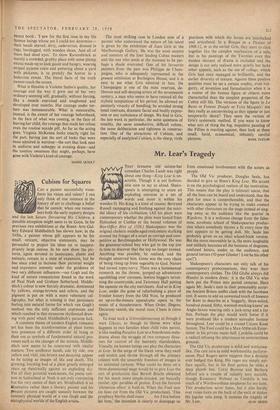Cubism for Squares
CAN a painter successfully trans- form his vision and talent? I can only think of one instance in the history of art to challenge a belief that he cannot; when one remem- bers both the early tapestry designs and the late Saturn Devouring His Children, a possible exception might seem to be Goya. In his previous two exhibitions at the Beaux Arts,Gal- lery Edward Middleditch has shown how, in the 1950s, a painter whose gift appears to be for small, reticent, objective statements, may be persuaded to project his ideas on to inappro- priately large canvas. In his new show the pic- tures, again devoted to landscapes, plants and animals, remain in a state of expansion, but he has since tried to increase their pictorial weight and expressive intensity under the guidance of two very different influences—van Gogh and the kind of nature romanticism found in the work of Paul Nash and Graham Sutherland. Middle- ditch's colour is now fiercely dramatic, dominated by yellows, orange-browns and ochres, and the pigment is put on with a more vehement cal- ligraphy, but what is missing is that passionate feeling into natural forms for which van Gogh's method was the only sufficient expression and which resulted in that strenuous rhythmical draw- ing with paint which Middleditch's pictures lack.
A common theme of modern English romantic art has been the transformation of plant forms into presences of a different order of being or their use as symbols of fundamental natural pro- cesses such as the changes of the seasons. Middle- ditch now seems to be concerned with similar matters. Two sunflower heads, side by side, one yellow and vital, one brown and decaying, appear to be acting as images of life and death. The growing, bursting bud of a plant greatly enlarged rears up theatrically against an exploding sky. For all their pictorial weaknesses, the poetic con- tent in Sutherland or Nash is not only convincing but the very centre of their art. Middleditch is an illustrative rather than a literary painter and his resent pictures are caught uneasily between the intensely physical world of a van Gogh and the metaphysical worlds of the English artists.
The most striking case in London now of a painter who understood the nature of his talent is given by the exhibition of Juan Gris at the Marlborough Gallery. He was the most austere and constant of the four leading Cubist masters and the one who tends at the moment to be per- haps a shade overrated. One of his favourite painters from the past was Philippe de Cham- paigne, who is adequately represented in the present exhibition at Burlington House, and it is easy to see what Gris admired in him. De Champaigne is one of the most reserved, de- liberate and self-denying artists of the seventeenth century, a man who seems to have resisted all the stylistic temptations of his period; he allowed no painterly vivacity of handling, he avoided strong tonal contrasts, dramatic facial and bodily expres- sion or any turbulence of design. We find in Gris, the late work in particular, the same quietness of tonality, the same unseductive, difficult colour, the same deliberation and tightness in construc- tion. One of the attractions of Cubism, and especially of analytical Cubism, is the sharp, virile
precision with which the forms are interlocked and articulated. In a Braque or a Picasso of 1908-12, or in the earlier Gris, they seem to click together like the complex mechanism of a safe, but in his paintings of the Twenties even this modest element of drama is excluded and the design is not only realised more quietly but lacks other appeals, such as the use of collage, which Gris had once managed so brilliantly, and the earlier diversity of texture. Against these positive qualities must be set a certain crudity, even vul- garity, of invention and formalisation when it is a matter of the human figure or objects more characterful than the simplest properties of the Cubist still life. The versions of the figure in Le Busse or Femme Drapee or Trois Masques: are they really as unconvincing as they appear or just temporarily dated? They seem the victims of Gris's systematic method. If you want to know what sort of thing the big, impulsive painting of the Fifties is reacting against, then look at these small, lucid, economical, infinitely careful


































 Previous page
Previous page